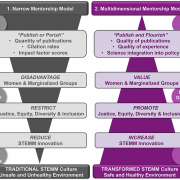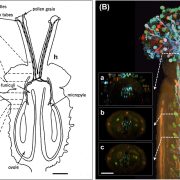Evolution of research topics and paradigms in plant sciences
 Is it possible to summarize objectively the recent history of plant science? Shiu and Lehti-Shiu have used a combination of machine learning and language modeling to track terms used in plant science articles from the 1950s to now, as a strategy to understand how research topics and tools have evolved. The records were clustered into 90 topics, which were named by the five most common terms defining them. As an example, the top topic since 1950 is listed as “QTL / resistance / wheat / markers / traits” and the third most common is “leaf / water / CO2 / trees / stomatal”. The topics were also clustered, forming for example a “development” topic cluster. Where this gets really interesting is where they start to look at trends over time. They identified five categories with different trends: stable, early, transitional, sigmoidal, and rising. Several of the rising categories include keywords that reflect current advancements in microbiome research, such as soil, rhizosphere, symbiosis, and mycorrhizal. Paradigm shifts from the pre-molecular era to the molecular era to the high-throughput -omics era are apparent (and thoughtfully discussed). The authors similarly discuss trends of taxa terms and research outputs by country. Interestingly, much of the growth in the past 20 years is attributed to research in India and China, and there has been an overall equalizing of plant science research with increasing impacts from countries without strong publication presences. (Summary by Mary Williams @PlantTeaching) bioRxiv https://doi.org/10.1101/2023.10.02.560457
Is it possible to summarize objectively the recent history of plant science? Shiu and Lehti-Shiu have used a combination of machine learning and language modeling to track terms used in plant science articles from the 1950s to now, as a strategy to understand how research topics and tools have evolved. The records were clustered into 90 topics, which were named by the five most common terms defining them. As an example, the top topic since 1950 is listed as “QTL / resistance / wheat / markers / traits” and the third most common is “leaf / water / CO2 / trees / stomatal”. The topics were also clustered, forming for example a “development” topic cluster. Where this gets really interesting is where they start to look at trends over time. They identified five categories with different trends: stable, early, transitional, sigmoidal, and rising. Several of the rising categories include keywords that reflect current advancements in microbiome research, such as soil, rhizosphere, symbiosis, and mycorrhizal. Paradigm shifts from the pre-molecular era to the molecular era to the high-throughput -omics era are apparent (and thoughtfully discussed). The authors similarly discuss trends of taxa terms and research outputs by country. Interestingly, much of the growth in the past 20 years is attributed to research in India and China, and there has been an overall equalizing of plant science research with increasing impacts from countries without strong publication presences. (Summary by Mary Williams @PlantTeaching) bioRxiv https://doi.org/10.1101/2023.10.02.560457



